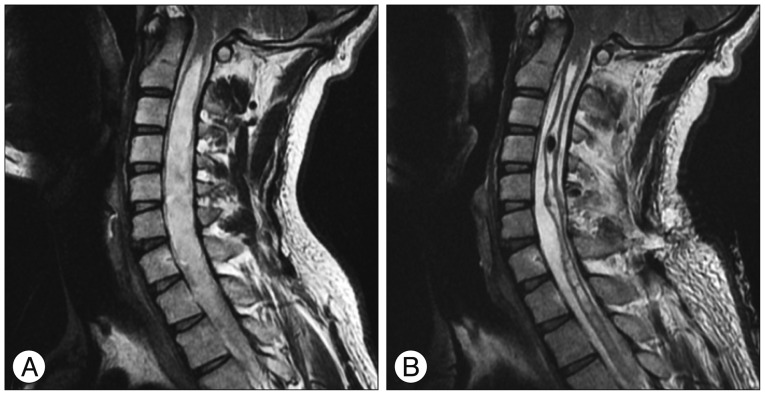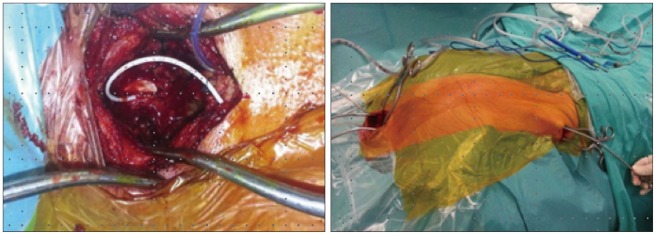J Korean Neurosurg Soc.
2015 Apr;57(4):311-313. 10.3340/jkns.2015.57.4.311.
Treatment of Syringomyelia due to Chiari Type I Malformation with Syringo-Subarachnoid-Peritoneal Shunt
- Affiliations
-
- 1Department of Neurosurgery, Bahcesehir University Medical School, Istanbul, Turkey.
- 2Department of Orthopedics-Spine Center, University of California at San Francisco, CA, USA. muratsakireksi@gmail.com
- KMID: 1956434
- DOI: http://doi.org/10.3340/jkns.2015.57.4.311
Abstract
- Chiari type I malformation is a tonsillar herniation more than 3 mm from the level of foramen magnum, with or without concurrent syringomyelia. Different surgical treatments have been developed for syringomyelia secondary to Chiari's malformations: craniovertebral decompression with or without plugging of the obex, syringo-subarachnoid, syringo-peritoneal, and theco-peritoneal shunt placement. Shunt placement procedures are useful for neurologically symptomatic large-sized syrinx. In this paper, authors define the first successful treatment of a patient with syringomyelia due to Chiari type I malformation using a pre-defined new technique of syringo-subarachnoid-peritoneal shunt with T-tube system.
Figure
Reference
-
1. Ataizi S, Canakçi Z, Baloğlu M, Cerezci A. Spontaneously resorbed idiopathic syringomyelia : a case report. Turk Neurosurg. 2007; 17:247–250. PMID: 18050066.2. Bosmia AN, Tubbs RI, Clapp DC, Batzdorf U, Loukas M, Tubbs RS. Johann Conrad Brunner (1653-1727) and the first description of syringomyelia. Childs Nerv Syst. 2014; 30:193–196. PMID: 24481626.
Article3. Chiari H. Ueber Veränderungen des Kleinhirns infolge von Hydrocephalie des Grosshirns. Dtsch Med Wochenschr. 1891; 17:1172–1175.
Article4. Depreitere B, Van Calenbergh F, van Loon J, Goffin J, Plets C. Posterior fossa decompression in syringomyelia associated with a Chiari malformation : a retrospective analysis of 22 patients. Clin Neurol Neurosurg. 2000; 102:91–96. PMID: 10817895.
Article5. Feldstein NA, Choudhri TF. Management of Chiari I malformations with holocord syringohydromyelia. Pediatr Neurosurg. 1999; 31:143–149. PMID: 10708356.
Article6. Gardner WJ, Goodall RJ. The surgical treatment of Arnold-Chiari malformation in adults; an explanation of its mechanism and importance of encephalography in diagnosis. J Neurosurg. 1950; 7:199–206. PMID: 15415776.7. Heiss JD, Suffredini G, Smith R, DeVroom HL, Patronas NJ, Butman JA, et al. Pathophysiology of persistent syringomyelia after decompressive craniocervical surgery. Clinical article. J Neurosurg Spine. 2010; 13:729–742. PMID: 21121751.
Article8. Hida K, Iwasaki Y. Syringosubarachnoid shunt for syringomyelia associated with Chiari I malformation. Neurosurg Focus. 2001; 11:E7. PMID: 16724817.
Article9. Hida K, Iwasaki Y, Koyanagi I, Sawamura Y, Abe H. Surgical indication and results of foramen magnum decompression versus syringosubarachnoid shunting for syringomyelia associated with Chiari I malformation. Neurosurgery. 1995; 37:673–678. discussion 678-679. PMID: 8559295.
Article10. Iskandar BJ, Hedlund GL, Grabb PA, Oakes WJ. The resolution of syringohydromyelia without hindbrain herniation after posterior fossa decompression. J Neurosurg. 1998; 89:212–216. PMID: 9688115.
Article11. Kim SH, Choi SW, Youm JY, Kwon HJ. Syringo-subarachnoid-peritoneal shunt using T-tube for treatment of post-traumatic syringomyelia. J Korean Neurosurg Soc. 2012; 52:58–61. PMID: 22993681.
Article12. Klekamp J. Neurological deterioration after foramen magnum decompression for Chiari malformation type I : old or new pathology? J Neurosurg Pediatr. 2012; 10:538–547. PMID: 23039841.
Article13. Loukas M, Noordeh N, Shoja MM, Pugh J, Oakes WJ, Tubbs RS. Hans Chiari (1851-1916). Childs Nerv Syst. 2008; 24:407–409. PMID: 18066558.
Article14. Markunas CA, Tubbs RS, Moftakhar R, Ashley-Koch AE, Gregory SG, Oakes WJ, et al. Clinical, radiological, and genetic similarities between patients with Chiari Type I and Type 0 malformations. J Neurosurg Pediatr. 2012; 9:372–378. PMID: 22462700.
Article15. Milhorat TH, Miller JI, Johnson WD, Adler DE, Heger IM. Anatomical basis of syringomyelia occurring with hindbrain lesions. Neurosurgery. 1993; 32:748–754. discussion 754. PMID: 8492850.
Article16. Naftel RP, Tubbs RS, Menendez JY, Wellons JC 3rd, Pollack IF, Oakes WJ. Worsening or development of syringomyelia following Chiari I decompression : case report. J Neurosurg Pediatr. 2013; 12:351–356. PMID: 23931767.
Article17. Navarro R, Olavarria G, Seshadri R, Gonzales-Portillo G, McLone DG, Tomita T. Surgical results of posterior fossa decompression for patients with Chiari I malformation. Childs Nerv Syst. 2004; 20:349–356. PMID: 15022006.
Article18. Oldfield EH, Muraszko K, Shawker TH, Patronas NJ. Pathophysiology of syringomyelia associated with Chiari I malformation of the cerebellar tonsils. Implications for diagnosis and treatment. J Neurosurg. 1994; 80:3–15. PMID: 8271018.
Article19. Tubbs RS, Webb DB, Oakes WJ. Persistent syringomyelia following pediatric Chiari I decompression : radiological and surgical findings. J Neurosurg. 2004; 100(5 Suppl Pediatrics):460–464. PMID: 15287455.
Article20. Van den Bergh R. Pathogenesis and treatment of delayed post-traumatic syringomyelia. Acta Neurochir (Wien). 1991; 110:82–86. PMID: 1882724.
Article21. Wetjen NM, Heiss JD, Oldfield EH. Time course of syringomyelia resolution following decompression of Chiari malformation Type I. J Neurosurg Pediatr. 2008; 1:118–123. PMID: 18352779.
Article22. Williams B. On the pathogenesis of syringomyelia : a review. J R Soc Med. 1980; 73:798–806. PMID: 7017117.
- Full Text Links
- Actions
-
Cited
- CITED
-
- Close
- Share
- Similar articles
-
- Evaluation of Syringo-Subarachnoid Shunt for Syringomyelia
- Syringo-Subarachnoid-Peritoneal Shunt Using T-Tube for Treatment of Post-Traumatic Syringomyelia
- Syringo-Pleural Shunt for Failed Syringosubarachnoid Shunt in Posttraumatic Syringomyelia
- Chiari Type I Malformation in a Child with Syringomyelia and Scoliosis: A case report
- Application of ventriculoperitoneal shunt as a treatment for hydrocephalus in a dog with syringomyelia and Chiari I malformation



